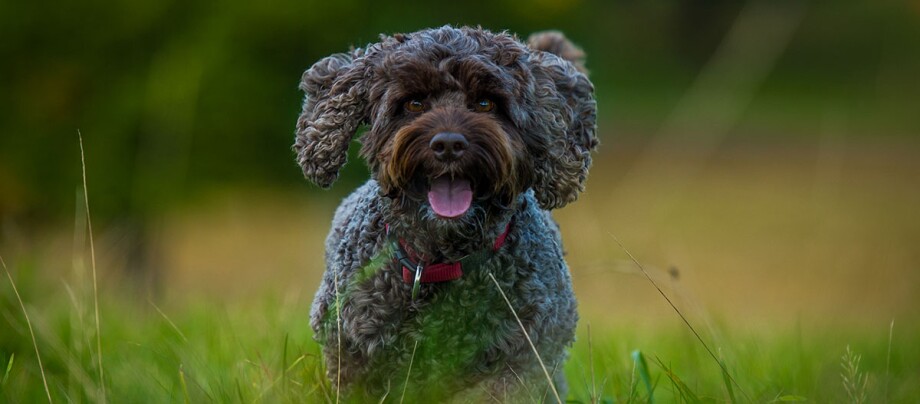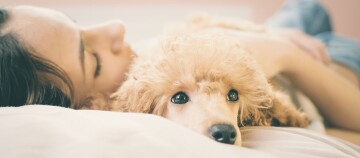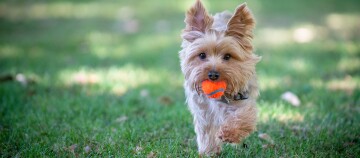Cockapoo – Savvy, Lovable, Cheerful, Charming and Eager to Learn
06.01.2024 - Reading time: 4 minutes

As a mix of the Cocker Spaniel and Poodle, the Cockapoo (also: Cockerdoodle and Cockerpoo) ideally combines the best traits of both breeds. The active and lovable hybrid dog can usually be easily trained and is thus also suitable for committed novice dog owners. The breed is not officially recognised; there are various colours and sizes. Nevertheless, the sociable Cockapoo has numerous fans and feels at home in families with children.
NewsletterCockapoo
Breed | Cockapoo |
Origin | USA |
Classification | Mix of English Cocker Spaniel and Poodle |
Weight | 3 to 10 kilograms |
Physique | Small to medium-sized dogs with a straight back and a long tail; larger Cockapoos have a stocky, strong body structure |
Eyes | Brown or black |
Ears | floppy ears |
Coat and colour | Longer or curly hair, all colours from black to white |
Special features | Visually, there can be significant variations between dogs |
Nature | Depending on the parents; mostly lovable, eager to learn, charming and cheerful |
Care | Regular brushing and clipping |
Health | Health: hereditary illnesses of the parent breeds may occur |
We have the best products for your Cockapoo!
Character of Cockapoos
Most Cocker/Poodle mixes are adaptable characters that enter into a close bond with their owners. They are predominantly friendly, intelligent, energetic and at the same time loveable and affectionate dogs who make wonderful playmates for children. Many of them are even suitable as therapy dogs.
The Cockapoo shows traits of both breeds. Poodles are intelligent and eager to learn, whereas English Cocker Spaniels are known for being passionate hunters. As this is a hybrid breed, it cannot be known in advance which character traits will prevail. It is thus indeed possible that your pet will demonstrate a pronounced hunting instinct.
Training and husbandry of Cockapoos
Even if the Cockerdoodle is fundamentally suitable for novices, regular activities and consistent training from puppy age are essential for a harmonious co-existence. Many Cockapoos love dog sports types such as dog dancing, agility or obedience or love bringing objects back. Whatever activity you opt for – it is important to sufficiently challenge the Cocker/Poodle mix and to give it sufficient exercise. Cockapoos do not like being alone and ideally want to be with you everywhere. If the animals are left alone frequently, they tend to bark and demonstrate destructive behaviour.
Caring for the Cockapoo
Many Cockerdoodles have curly, semi-long fur that requires intensive fur care so that it does not matt. Burrs or small twigs like to attach themselves to the tousled fur and these have to be removed. Ideally, you must comb your dog daily or several times a week. If your Cockapoo does not exhibit seasonal moulting, you should have it clipped regularly. Whether your dog loses a lot of hair depends on whether the genes of the Poodle or those of the Cocker Spaniel are dominant.
Regular ear care is important because dirt often accumulates in the floppy ears of the animals. Painful inflammations can develop if they are not looked after properly.
Colours of the Cockapoo
Depending on the parent animals and the mix, Cockapoos can have various fur colours – there are dogs with different colours of fur as well. The colour variations of the Cockapoo are black, brown, white, silver, beige and apricot. Depending on the pairing, the fur is curly to wavy.
Origin and lineage of the Cockapoo
The first Cockapoos emerged in the US in the 1950s when breeders began to pair American and English Cocker Spaniels with Poodles. Their likeable nature quickly made Cockapoo dogs popular. Although there have been several attempts since, the Cockapoo has not been recognised as a separate breed to date. Since 1999, there is the Cockapoo Club of America which defines important standards. The price for a Cockapoo from a reputable breeder is between around 800 and 1,200 euros.
Special characteristics of the Cockapoo
Cockapoos can be found in various sizes. Which shoulder size the adult dog has depends on the Poodle. A Teacup Cockapoo remains small with a size of between 20 and 30 centimetres whereas a Toy Cockapoo measures around 35 centimetres. A Miniature Cockapoo reaches a height of up to 40 centimetres; the Maxi Cockapoo is the largest mix with up to 45 centimetres. The life expectancy of the Cockerdoodle is relatively high, at 14 to 16 years.
Cockapoos do not have any papers, which means that you should check the parents thoroughly with regard to hereditary illnesses. The parents may pass on health impairments to the puppies.
The known hereditary illnesses include deformities of the hip joint (hip dysplasia) as well as a condition in which the patella, or kneecap, dislocates or moves out of its normal location (patella luxation). Illnesses of the retina (progressive retina atrophy) can also occur as well as clotting disorders (von Willebrand disease) and damage to the spinal cord (degenerative myelopathy). Some gold-coloured and red Cocker Spaniels in particular have an unexpected and unexplained aggressiveness, so-called “Cocker rage”.





